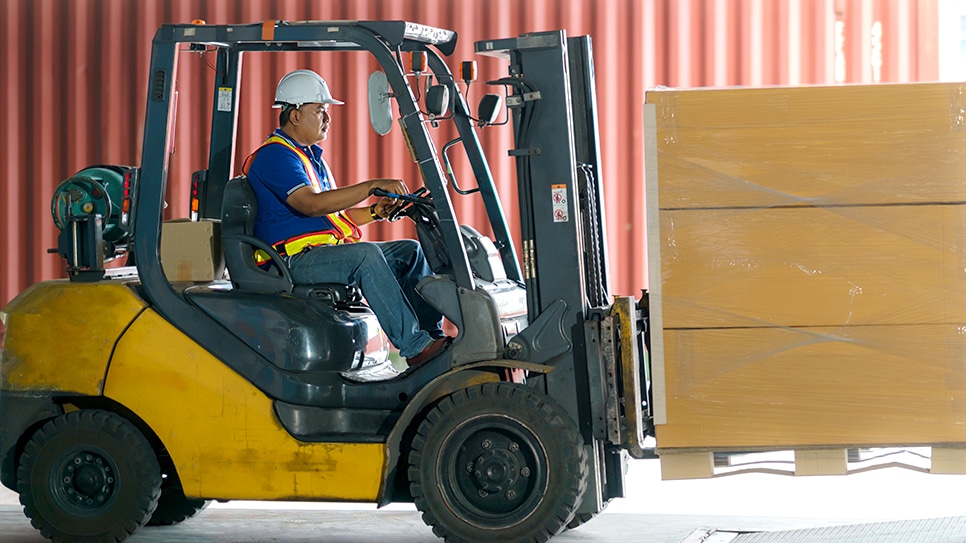
Materials Handling, Storage, Use, and Disposal Training for Employees
Properly handling materials manually or with the help of mechanical equipment keeps workers safe and productive at work.
Course description
Traliant’s Materials Handling, Storage, Use and Disposal training is a 35-minute course explaining how to smartly and safely lift heavy objects to prevent back sprains, muscle pulls, wrist injuries, elbow injuries and avoid other serious hazards posed by materials handling equipment.
This course aligns with the Occupational Safety and Health Administration’s (OSHA) recommendations to focus materials handling training on reducing the dangers of lifting, avoiding physical stress and strain, awareness around materials handling equipment and how to recognize and prevent potential materials handling hazards.
ONLINE TRAINING
Materials Handling, Storage, Use, and Disposal Training for Employees

Materials handling covers these topics and more:
- What is materials handling
- Types of materials handling equipment
- Hazards associated with materials handling (environmental, chemical and physical)
- How to handle common types of hazardous waste
- Hazards associated with materials handling and how to avoid them
- Employer requirements to protect workers from materials handling hazards
KEY FEATURES
Why you'll love our training
It’s time to embrace a new era of online training with a valued partner who will ensure seamless implementation, along with a learning experience your employees will truly enjoy.
Course administration
Traliant makes it simple to roll out training to your workplace and provide technical support directly to your employees at no additional cost.
Course customizations
Tailor courses to include your logo, relevant policies, workplace images, and more. Traliant can even customize the course with scenarios that take place in your own workplace environment.
Translations
Training is available in English, Spanish and is supported in over 100 languages.
What to consider when choosing the most effective materials handling, storage, use, and disposal training

- Prevent injuries: Improper materials handling is a leading cause of workplace injuries, including back injuries, strains, and sprains. Training helps to reduce the risk of these incidents by teaching employees how to handle materials correctly and safely.
- Comply with OSHA regulations: OSHA requires employers to provide training on materials handling to employees who are exposed to these hazards. Training helps organizations meet these legal requirements.
- Improve efficiency and productivity: Proper materials handling techniques can help to improve efficiency and productivity in the workplace.
- Empower employees: Training provides employees with the knowledge and skills they need to make informed decisions about materials handling and to protect their safety.
- Strengthen your organization's commitment to safety: Training demonstrates the company's commitment to providing a safe working environment and to protecting the health of its employees.
- Reduce the risk of accidents and injuries: When employees understand how to handle materials safely, they are less likely to be injured.
- Lifting and carrying.
- Pushing and pulling.
- Stacking and storing.
- Loading and unloading.
- Using materials handling equipment.
- Forklifts: Used to lift and move heavy loads.
- Pallet jacks: Used to move pallets of materials.
- Conveyors: Used to move materials along a fixed path.
- Cranes and hoists: Used to lift and move extremely heavy loads.
- Environmental hazards: Slippery floors, poor lighting, and extreme temperatures.
- Chemical hazards: Exposure to hazardous chemicals, such as solvents, acids, and pesticides.
- Physical hazards: Manual lifting of heavy objects, awkward postures, repetitive motions, and forceful exertions.
- Plan the lift: Before lifting, assess the weight of the object and plan your route.
- Use proper lifting techniques: Keep your back straight, lift with your legs, and avoid twisting.
- Get help if needed: Don't try to lift objects that are too heavy for you. Ask for assistance from a co-worker or use mechanical equipment.
- Wear appropriate PPE: Wear appropriate personal protective equipment (PPE), such as gloves and safety shoes.











